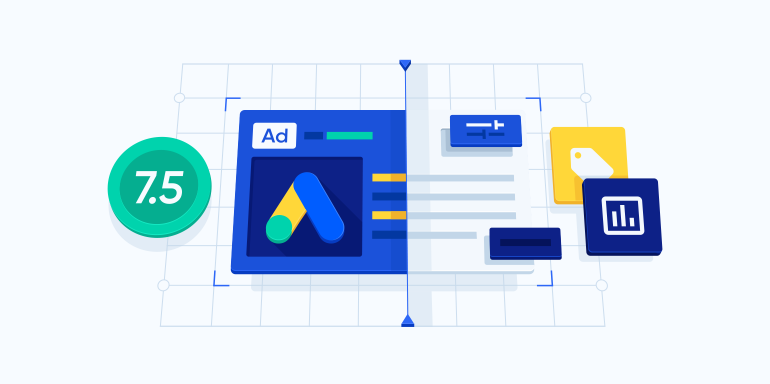- What is Google Ads Quality Score?
- Difference between Quality Score & Ad Rank
- How is Quality Score calculated?
- Expected CTR
- Ad Relevance
- Landing Page Experience
- High QS doesn’t always mean...
- How to improve landing page experience
- Faster page load times
- Offer relevant content
- Make sure the content is useful
- Design with the visitor in mind
- Promote trust & transparency
- How Postclick improves the LPE for clients
You’ve narrowed your keywords, written compelling ad text, and created a great landing page. But when you check your Google Ads Quality Score, you find it’s below average.
Don’t panic. Though a low Quality Score can translate to wasted ad budget and poor campaign performance, there’s lots you can do to improve it. Before you start, though, it’s important to know how Google is grading you and why it’s so important.
What is Google Ads Quality Score?
Quality Score is a form of measurement used by Google Ads to inform advertisers of the likelihood their campaign will perform well. From 1-10, Google grades campaigns in three areas: keywords, ads, and landing pages. With this estimate from Google, advertisers can work to improve areas of their campaign that may improve Ad Rank. Quality Score can be viewed in the “Quality Score” column of a Google Ads report:
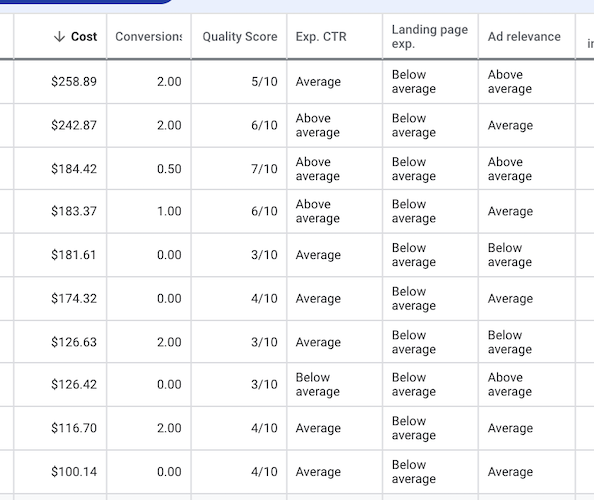
The difference between Quality Score and Ad Rank
Quality Score and Ad Rank are easy to confuse. They both seem like Google’s way of evaluating your campaigns. And though they are related, they’re not the same.
Quality Score is Google’s way of giving advertisers a tool with which to improve their campaigns. When keywords, ads, and landing pages get evaluated, Quality Score informs advertisers how to adjust their campaign accordingly.
Ad Rank, on the other hand, is Google’s way of taking into account much more campaign information to determine where your ad will show up on search engine results pages (SERP). When Google determines Ad Rank, it does take into account keyword, ad, and landing page experience, just like Quality Score. However, it also takes into account, according to Google:
Ad Rank is calculated using your bid amount, your auction-time ad quality (including expected clickthrough rate, ad relevance, and landing page experience), the Ad Rank thresholds, the competitiveness of an auction, the context of the person’s search (for example, the person’s location, device, time of the search, the nature of the search terms, the other ads and search results that show on the page, and other user signals and attributes), and the expected impact of extensions and other ad formats.
With these factors, Google determines where to show your ad in relation to other ads on search engine results pages, or if it should be shown at all. Ad Rank does not directly take Quality Score into account. Just because you have a high Quality Score doesn’t mean that your campaign will have a high Ad Rank. At the same time, Ad Rank does take into account the same factors as Quality Score. And they are a key part of improving your Ad Rank. This is why Quality Score is such a valuable self-diagnostic for advertisers.
How is Quality Score calculated?
When Google calculates Quality Score, it takes into account three factors related to keywords, ads, and landing pages. These are known as:
- Expected CTR
- Ad Relevance
- Landing Page Experience
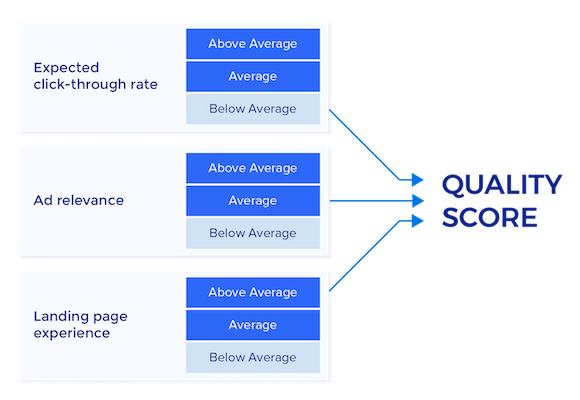
As you read, keep in mind that Google weighs these factors differently when evaluating your campaigns. According to research, expected click-through rate and landing page experience contribute more to Quality Score than ad relevance:
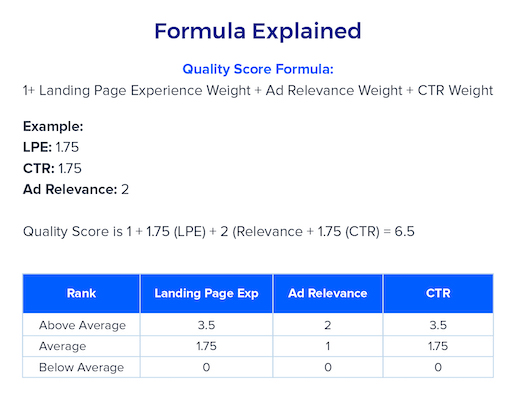
Expected CTR
Expected CTR is a keyword-related factor that measures how likely it is someone will click your ad when searching for the keyword associated with it. This metric does not take into account ad position, extensions, or other ad formats that may make your ad more or less visible.
What it does take into account is past keyword performance based on ad position. How well has this keyword performed in the past based on where the ad is shown? Ultimately Google wants to find out how likely your keyword will result in a click-through.
In determining Quality Score, expected CTR is based on the idea that the user’s search term will match your keyword exactly. In real-time, Google uses a more accurate expected CTR based on search terms but also the type of device and other auction factors.
If you have an average or above average expected CTR, that means your expected click-through rate for this keyword is as good or better than all other keywords on the Google Ads network.
On the other hand, if your expected click-through rate is below average, it means the opposite. Your click-through rate for this particular keyword is expected to be lower than all keywords across Google ads. If this is the case, consider adjusting your ad text to make it better match your keyword.
Ad Relevance
Ad relevance, like estimated CTR, is related to your keyword. In this case, though, it’s more about: Is your ad copy and relevant to the keywords in your ad group?
For example, keywords like “content marketing agency” or “web design agency” might be relevant to your marketing agency, but if you’re using the same ad for both keywords, you’re going to sacrifice relevance. This is what ad relevance is measuring.
If your ad relevance is below average, check to make sure your keyword groups aren’t too broad. The more relevant your ad is to your keyword groups, the more likely you are to have a high ad relevance. For the searcher, this translates to a more valuable campaign experience, which is why it’s emphasized in Quality Score.
Landing Page Experience
When Google measures your landing page experience, it’s measuring “how relevant and useful your website’s landing page will be to people who click your ad.”
But what makes a good landing page experience? According to Google, your page should be “clear and useful,” and “related to your keyword and what customers are searching for.”
While a good start, these instructions are quite vague. What’s “clear and useful”? And how “related” should a page be to its keyword?
- Clear: Your page should be created with landing page design best practices. That means keeping your conversion ratio to 1:1, using visual hierarchy to guide users to conversion, making sure copy is minimal (on most pages) and skimmable, media is engaging and informational, and there is a clear way forward through a call-to-action.
- Useful: Design is one thing, content is another. What did you promise in your ad? The content should be easy to consume (use infographics and get rid of jargon) and help people figure out if the offer you promised is worth claiming. Make sure your page includes everything they need to know about your offer to make a decision.
- Relevant: You should not be driving customers to a homepage or a product page or any page that is not designed specifically for your offer. The more relevant your page is, the more personalized it is to the visitor. And personalization is a powerful effector of buying decisions.
To achieve the highest level of personalization, each audience should have its own page. Important targeting factors like location and behavior should be factored into your designs. And your page shouldn’t just be related to your ad’s keyword — it should contain it in the headline and throughout the page.
High Quality Score doesn’t always translate to a high performing campaign
Earlier, you learned that Google takes more into account than ads, landing pages, and keywords when it decides where to show your campaign. It’s important to reinforce the fact that Ad Rank is based on many other factors. For example, if you’re an advertiser with a high Quality Score, but your bid is low, don’t be surprised if your campaign isn’t showing in high-visibility positions. Your bid is a major effector of ad position.
However, this works both ways. Some advertisers think they can bid their way to the top. With a big budget, they throw money at Google thinking it will guarantee them a high-visibility ad position. But with bad ads, keywords, and landing pages, it’s very likely a campaign won’t score high on Ad Rank, no matter how much they bid. If you’re a business with a smaller budget but a better campaign, you can overtake bigger advertisers on search engine results pages:
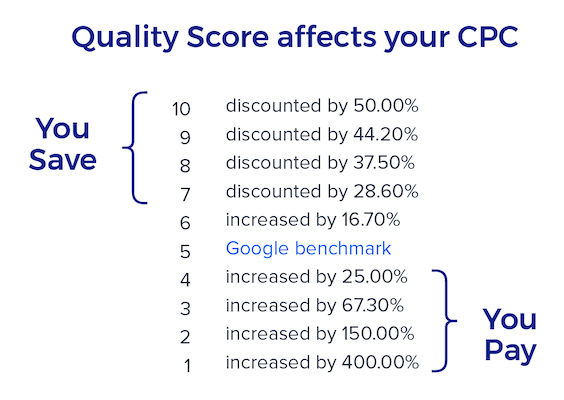
How to improve landing page experience
Improving expected CTR and ad relevance seems fairly straightforward compared to improving the landing page experience. The first two have a lot to do with keywords and creating clickable ad copy. Landing page experience, though, encompasses so much. When your Quality Score indicates a poor landing page experience, how do you raise it?
1. Improve landing page load time
There is no worse experience for a visitor than clicking an ad and not reaching the post-click landing page quickly. When your page loads slowly, don’t expect visitors to watch a loading screen for longer than a moment. At three seconds, 53% of traffic has abandoned your page if it hasn’t loaded:

What’s worse, they won’t just abandon your page. Once they leave, they’re likely going to a competitor for what you failed to provide.
If your page doesn’t load instantly, consider speeding it up by getting rid of all excess images. In a study of 900,000 mobile landing pages, Google found that the elements with the most “weight” in data were images. These were bogging down pages and contributing to slow load times more than any other factor.
Another way to speed your page is by building it with AMP. And if you’re writing it off because you read about it when it came out, you should know it’s undergone so many developments that it’s nearly unrecognizable outside of its main goal: to speed landing pages. It’s not just for mobile anymore, there are JavaScript workarounds, and with new components you can create versatile pages capable of complex processes including checkouts.
To further speed your page, get rid of excess JavaScript, consider loading your page asynchronously, reduce redirects and try caching your pages. Find out more tips on how to speed load time here.
2. Offer relevant content
Your ad isn’t the only place where relevance should be high. In fact, relevance is arguably even more important on your landing page.
Here is where you elaborate on the content of your ad. On the landing page, you are delivering what you might consider a more robust advertising user experience. You have to expand on the copy and match the headline of your ad to the headline of your landing page; you have to personalize content to each member of your audience to ensure their needs are entirely met; and you should be testing your pages constantly to make them more and more tailored to the preferences of your visitors.
Do not drive visitors to a homepage, pricing page, or anywhere else not designed specifically for the offer advertised. When you do this, you force visitors to hunt for more information on your offer. And it’s unlikely they will. What’s more likely is they go to a competitor who provides a better landing page user experience.
3. Make sure your content is useful
A page can be personalized, taking into account targeting factors like age and location but still be useless. To create a useful page, copywriters and designers need to make it easy for visitors to decide whether they want to claim your offer. That means:
- Creating a headline that inspires trust by matching the headline of the ad
- Replacing industry jargon with easy to understand language
- Discovering if you can eliminate excess form fields
- Making your page skimmable for busy customers
- Using infographics when they can help visitor comprehension
- Discovering buyer objections and overcoming them all in media or text
Here’s an example of a form that doesn’t waste time with optional fields. It only requests the information required by marketing and sales to move the prospect to the next stage of the funnel.

4. Design your page with the visitor’s goal in mind
Your goal and the goal of your visitor overlap. They want to claim an offer, and you want them to claim yours. So when you design your page, guide them to your CTA with visual elements. That means:
- Identifying yourself with a logo in the upper-left corner of your page
- Eliminating navigation to keep visitors from getting distracted by other links on your website
- Structuring your page to accommodate the “F” pattern for text-heavy pages, and the “Z” pattern for pages with images
- Making your headline big, bold, and benefit-oriented to draw visitors into the page
- Adhering to laws of layout. Don’t try to be unique by breaking established rules of the internet, like breaking the left margin
- Bulleting, bolding, italicizing important text on your landing page to make it more noticeable
- Leveraging laws of color and contrast to make your CTA button stand out
Here’s an example of a call-to-action that does a great job of contrasting its background:
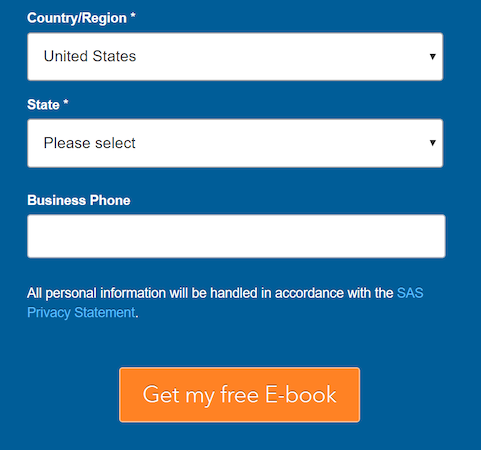
5. Promote trust and transparency
Consumers rank advertisers among stockbrokers, governors, lawyers, and members of congress, as the least trustworthy in the professional world. So expect visitors to look for every reason to abandon your landing page. From securing your page to fixing broken links, send signals that say you’re trustworthy:
- Secure your page with SSL protection. If you don’t, browsers will communicate with a warning icon in your URL that your page is not safe for secure data transfer
- Use security icons, like Norton Secure badges or locks, where your visitors have to input information to communicate to them that you are handling their data with care
- Include a link to your privacy policy around those badges and forms. This isn’t just a recommendation, it’s a requirement that GDPR regulators have zeroed in on
- Include social proof, like testimonials, which show that other customers have found your offer valuable
- Include authority indicators, (e.g. awards won or well-known partner logos) show visitors you are respected and trustworthy
Here’s an example of some good testimonials from Bitdefender:

A common thread unites all three components of Quality Score: relevance. All your keywords, ads, and landing pages must be as relevant as possible to the user.
Achieving this requires a high level of campaign personalization. And, while scaling keyword and ad personalization is possible with Google’s self-serve tools, there’s no adequate solution for landing pages. With Postclick, though, teams of any size can improve Quality Score and Ad Rank by providing the most personalized landing pages possible.
How Postclick improves the landing page experience
Postclick, the new tech-enabled service that puts your campaigns in the hands of seasoned conversion professionals, can improve your landing page experience immediately.
When you partner with Postclick, you get a service that operates as an extension of your business. Before the team even touches your Google Ads campaigns, they get to know your brand on a level that allows them to operate as efficiently as your own employees. And that’s because only someone who knows your tone of voice, design style, customers, etc., is qualified to create experiences on your behalf.
The Postclick team wants to know:
- What am I looking at? To understand what you’re offering specific to the query that was searched. It helps the Postclick team review the keyword and ad intent to identify a narrative and create a persona. Thus, helping them create better post-click destinations focused on conversion-centric design and storytelling.
- Who is it for? You have many segmented audiences with narrow targeting parameters. Each post-click page needs to be tailored to each segment. This helps Postclick create the most personalized page possible.
- Why should your customer care? Every offer has a unique selling proposition. Why should visitors claim yours and not your competitors? This helps Postclick determine the most persuasive aspects of your campaign to highlight on the landing page.
- How does it work? The goal of every post-click landing page is to get a visitor to take action. But that action is different depending on the campaign. Are you trying for signups? Downloads? Purchases? And when they click the call-to-action, where do you want your visitors to go next? Are you using a two-step form? A click-through sales page? Will they get an onboarding email? These are all relevant to the next steps in campaign design.
These questions are just the beginning of communication between Postclick and its partners. But the end goal is always the same: Improve campaign performance by empowering conversion veterans to scale personalization throughout all campaigns with post-click automation.
The Postclick team uses Instapage, the industry’s only platform capable of creating a personalized post-click landing page for every audience because every segment deserves its own post-click landing page.
Conversion happens on the post-click landing page, and Postclick customers see conversion rates 4x higher than the average 4.40%. When you put Instapage in the hands of conversion experts, even higher conversion rates are achievable. Find out how Postclick can improve your conversion rates by contacting the team here.
